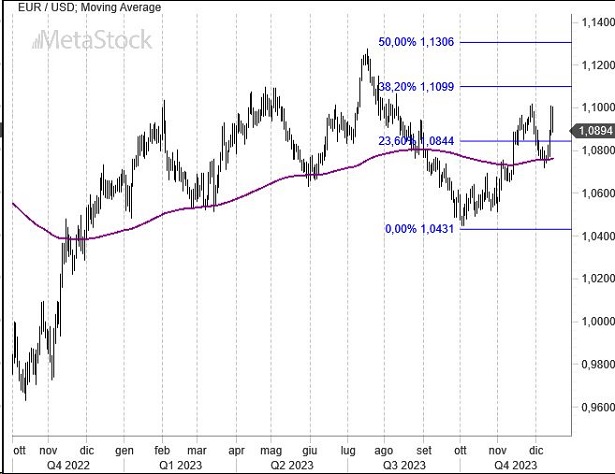- Powell confirms the end of the interest rate hike cycle and anticipates future rate cuts as inflation approaches 2%. Both the stock and bond markets celebrate, buoyed by the prospect of more relaxed monetary policy.
- The ECB does not align with the Fed, emphasizing the ongoing need to remain vigilant about inflation, which will require a prolonged period of high interest rates.
- EurUsd approaches the 1.10 resistance area (but does not break through) following the Fed’s decision. The potential for rate cuts in the U.S. weakens the dollar due to the prospect of lower yields on U.S. securities.
U.S. Interest Rates Cuts on Horizon, ECB Holds Firm
U.S. interest rates remain steady at 5.5%, the highest in 22 years, but prospects of multiple rate cuts in 2024 are opening up. Analysis of the Federal Reserve’s “dot plots” shows that various Fed governors foresee at least two rate cuts next year, with expectations of a decrease to around 4.5%-4.75% by year-end. By 2025, rates are projected to fall by another percentage point, coinciding with inflation returning to 2%. Economic growth, however, is expected to remain modest, forecasted below 2% for both 2024 and 2025. Regarding recent data, U.S. inflation has stayed as anticipated, around 4% for the core rate and 3.1% for the headline rate.
The European Central Bank (ECB) disappointed markets with less dovish tones than expected, missing an opportunity to celebrate the conclusion of the central banks’ two-day meeting. ECB President Lagarde remained noncommittal on future monetary policy, emphasizing the long path to bringing inflation back to 2% and noting the potential complications posed by wage pressures. The ECB also indicated that inflation might temporarily surge in early 2024 due to seasonal factors. Nonetheless, consumer price index forecasts for 2024 have been revised downward to 2.7% and to 2.1% for 2025. No discussions on interest rate cuts were mentioned, and upcoming data will be crucial in shaping the ECB’s rate trajectory for the new year. The PEPP, the liquidity injection program initiated during the pandemic, is set to conclude in 2024.
Technical Analysis – EurUsd’s Momentum and Key Resistance Levels
After a brief dip below the 200-day moving average, EurUsd has reclaimed what had become a resistance level and then executed a classic pullback, gaining momentum after the Fed meeting. This movement suggests the end of a consolidation phase that started a year ago, with the euro potentially targeting the 1.15 area (61.8% projection of the first bullish leg) and possibly even 1.22 (where both bullish legs would be equal) in the best-case scenario for the European currency.

However, the real challenge for EurUsd in entering a bull market is the 200-week moving average. As seen in the second chart, throughout 2023, EurUsd repeatedly tested this dynamic resistance, briefly breaking above it before retreating. The critical price level now is 1.10; surpassing this would signal EurUsd’s intention to embark on an upward trajectory. However, the recent attempt to breach this threshold appears to have fallen short of expectations.


Leave a Reply
You must be logged in to post a comment.